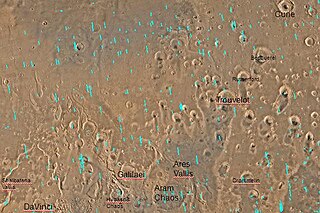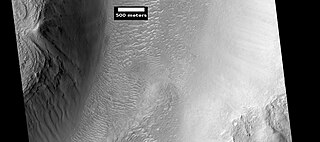
Burma-Shave was an American brand of brushless shaving cream, famous for its advertising gimmick of posting humorous rhyming poems on small sequential highway roadside signs.

A transit of Mercury across the Sun as seen from Mars takes place when the planet Mercury passes directly between the Sun and Mars, obscuring a small part of the Sun's disc for an observer on Mars. During a transit, Mercury can be seen from Mars as a small black disc moving across the face of the Sun.

A transit of Deimos across the Sun as seen from Mars occurs when Deimos passes directly between the Sun and a point on the surface of Mars, obscuring a small part of the Sun's disc for an observer on Mars. During a transit, Deimos can be seen from Mars as a small dark spot rapidly moving across the Sun's face.

A transit of Phobos across the Sun as seen from Mars takes place when Phobos passes directly between the Sun and a point on the surface of Mars, obscuring a large part of the Sun's disc for an observer on Mars. During a transit, Phobos can be seen from Mars as a large black disc rapidly moving across the face of the Sun. At the same time, the shadow (antumbra) of Phobos moves across the Martian surface.
Planetary engineering is the development and application of technology for the purpose of influencing the environment of a planet. Planetary engineering encompasses a variety of methods such as terraforming, seeding, and geoengineering.
A flag of Mars is a flag or flag design that represents the planet Mars or that represents a fictional Martian government.

Mars is the fourth planet from the Sun and the second-smallest planet in the Solar System, being larger than only Mercury. In the English language, Mars is named for the Roman god of war. Mars is a terrestrial planet with a thin atmosphere, and has a crust primarily composed of elements similar to Earth's crust, as well as a core made of iron and nickel. Mars has surface features such as impact craters, valleys, dunes, and polar ice caps. It has two small and irregularly shaped moons: Phobos and Deimos.
Burmese people in the United Kingdom are residents and citizens of the United Kingdom with Burmese ancestry or origins. This can include people born in the UK who are of Burmese descent, as well as those born in Myanmar who have migrated to Britain.

Hydaspis Chaos is a region in the Oxia Palus quadrangle of Mars, located at 3.2° north latitude and 27.1° west longitude. The region is about 355 km across. It was named after a classical albedo feature.

Endeavour is an impact crater located in the Meridiani Planum extraterrestrial plain within the Margaritifer Sinus quadrangle (MC-19) region of the planet Mars. Endeavour is about 22 kilometers (14 mi) in diameter. Using Mars Reconnaissance Orbiter data, phyllosilicate-bearing outcrops have been detected along its rim. These minerals may have formed under wet conditions in a low-acidic environment during the early history of Mars. There are raised rim segments to the north, east, and southwest. The rim has become worn, rounded and degraded, with infilling of plains material in a manner similar to the Victoria crater.

The Tempe Fossae are a group of troughs in the Arcadia quadrangle of Mars, located at 40.2° north latitude and 71.4° west longitude. They are about 2,000 km long and were named after an albedo feature at 40N, 70W.

The Tractus Fossae are a set of troughs in the Tharsis quadrangle of Mars, located at 26° north latitude and 101.4° west longitude. They are 390 km (240 mi) long and are named after a classical albedo feature name. The term "fossae" is used to indicate large troughs when using geographical terminology related to Mars. Troughs, sometimes also called grabens, form when the crust is stretched until it breaks, which forms two breaks with a middle section moving down, leaving steep cliffs along the sides. Sometimes, a line of pits form as materials collapse into a void that forms from the stretching.

Many areas on Mars experience the passage of giant dust devils. These dust devils leave tracks on the surface of Mars because they disturb a thin coating of fine bright dust that covers most of the Martian surface. When a dust devil goes by it blows away the coating and exposes the underlying dark surface. Within a few weeks, the dark track assumes its former bright colour, either by being re-covered through wind action or due to surface oxidation through exposure to sunlight and the Martian atmosphere.

Cyane Fossae is a trough in the Diacria quadrangle of Mars. It is centered at 31.3° north latitude and 121.2° west longitude. It is 913 kilometres (567 mi) long and was named after a classical albedo feature name.

Labeatis Fossae is a large trough in the Lunae Palus quadrangle of Mars, located at 25.5° N and 84.1° W. It is 1,560.0 km long and was named after a previously named feature at 30N, 75W.

"Moving to Mars" is a song by British alternative rock band Coldplay. It was written by all members of the band for their fifth studio album Mylo Xyloto. However, it failed to make the final track listing. Instead, it was released in the Every Teardrop Is a Waterfall iTunes exclusive EP. The first half of the song is a piano based ballad, while the rest of it is a mid-tempo number with progressive rock influences.

The Amenthes Fossae are a system of troughs in the Amenthes quadrangle of Mars centered at 9.07°N and 102.68°E. They are 850 km across and were named after a classical albedo feature. The classical albedo feature name was based on the Egyptian name for a place where souls of the dead go. The name Amenthes Fossae was approved in 1976.
Moving to Mars can refer to:

Nili Patera is a dune field on Mars. It is located on top of a lava bed, at the site of an ancient volcano, the Nili Patera caldera of Syrtis Major, near the Martian equator, and it is one of the most active dune fields of Mars. Its location coordinates on Mars are 8.7° N latitude, 67.3° E longitude. It is being actively studied by the HiRISE camera, on board the Mars Reconnaissance Orbiter, at the rate of one image every six weeks. The study of the movement of the dunes provides information regarding wind variation as a function of time and furthers the study of surface erosion characteristics of the Martian landscape. This information can then be used for the development and design of future Mars expeditions. The dunes of the Patera field are of the barchan type and their study by HiRISE was the first one to establish dune and ripple movement of a minimum of 1 metre on Mars. The Patera dune field, was also the first to be investigated using the COSI-Corr software, which was originally developed to analyse the movement of earthbound dunes. The research results from the evidence provided by the monitoring of the Nili Patera field, indicate sand fluxes of the order of several cubic metres per metre per year, similar to the flux observed at the sand dunes of Victoria Valley in Antarctica.

MiMi Aung is a Burmese-American engineer and project manager at NASA's Jet Propulsion Laboratory (JPL). She is a lead engineer on the Mars Helicopter Ingenuity, the first extraterrestrial aircraft.















